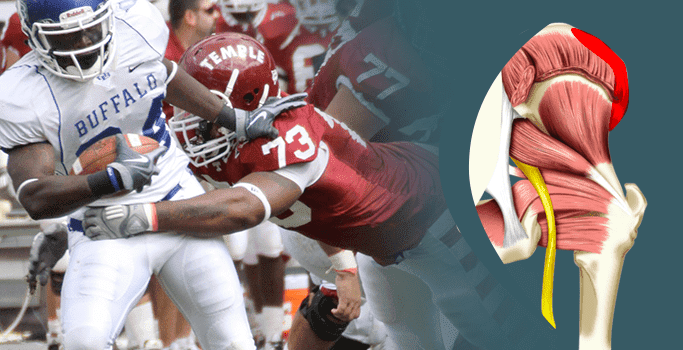A hip pointer wound is a very common injury received by athletes or people playing sporting activities. Defined as a contusion or bruise on the upper portion of the hip bone, known by the medical term iliac crest, a hip pointer is often accompanied by a second wound on the abdominal muscles. Many people mistakenly believe that it is the hip bone that becomes wounded but it is actually the connecting muscle tissue that gets injured in a hip pointer injury.
Hip pointer injuries can usually be detected right away, expressed by severe discomfort in the groin, side of the body around the area of the hip, and associated exterior bruising. The discomfort felt in the hips can be quite strong, exacerbated when the injured person walks, laughs, sings, coughs, or even breathes deeply. The hip pointer wound causes a minor amount of internal bleeding in the muscle tissues that surround the hip. These muscles then become inflamed and start to expand, causing any movement of the associated leg to be quite uncomfortable.
Hip pointer wounds are most commonly sustained by people who play contact sports, including American football, skiing, lacrosse, cycling, and hockey. A direct strike against the top, outer part of the hip can lead to a bit of the bone being clipped off. These types of wounds can result as either a hard strike from another person, a ball, or by falling to the ground and ramming against a hard surface.
While few hip pointer wounds become serious enough to merit specialized medical care, these types of wounds require a significant amount of rest to create the conditions for proper healing. Sports medicine experts estimate that it takes between one and seven weeks for an individual with a hip pointer wound to fully recover from the injury to their hip bone, hip muscles tissues and ab muscles.
Any person who engages in aggressive or high-velocity sports and fails to wear protective cushioning on their hips is at the highest risk of sustaining a hip pointer wound. Athletes who play American football are statistically most likely to sustain a hip pointer wound due to the nature of the sport which involves hard blows to the hip from other players, especially from their helmet or hardened shoulder pads. American football players are also at a higher risk of developing this type of wound because tackles can involve a hard slam against the ground.
Other types of vigorous play, including lacrosse, soccer, gymnastics, hockey, skiing, and bicycling can also precipitate an increased risk of developing a hip pointer wound due to the frequent nature of either hard blows received from other players and/or balls or slamming against the ground and landing on an unyielding surface.
Hip pointer wounds are rarely diagnosed in a doctor’s office. A number of symptoms can indicate the presence of a hip pointer injury, including:
- Inflammation, discoloration and/or bruising around the hip.
- Moving around with a limp.
- Experiencing sudden discomfort in the hip right a rough fall or hit.
- Discomfort in the hip area that is exacerbated when running, dancing, bending, walking, jumping, or twisting.
- A limited ability to move and/or bend the hip joint.
- Muscle tissue spasms in and around the hip.
- Obvious loss of power in the hip area.
- A quick deterioration of leg and hip function on the side of the body that was wounded.
Most hip pointer wounds can be treated without emergency medical intervention. The standard recommended treatment for a hip pointer wound is to rest for the first 48 hours. During the first two or so days, it is recommended that anyone who sustained a hip pointer wound apply cold packs for 20-25 minutes on a schedule of three to four times a day as long as the cold is not applied directly to naked skin. It is also counseled to maintain the injured hip and/or leg elevated for the first day or so.
Starting on the third day, the standard course of treatment for a hip pointer wound is to begin to slowly and gently stretch the area, focusing on strength-building routines to add flexibility and power back to the area. Some individuals with a hip pointer wound find it advantageous to take over the counter pain drugs like ibuprofen to minimize discomfort and tenderness.
While there is usually no long-term damage associated with hip pointer wounds, receiving a blow or taking a tumble can result in a very uncomfortable condition. Anyone who received a hip pointer injury will have to carefully begin to apply physical therapy techniques to recover their full range of flexibility. Some physical therapists recommend using special massages and movement exercises once the primary discomfort of a hip pointer wound has faded away. In some severe cases, it may be necessary to receive a corticosteroid solution inserted into the area in order to minimize tenderness and inflammation and hasten full use of that region of the body.
Surgical intervention for a hip pointer injury is extremely rare and should only be undertaken if there is a confirmed diagnosis that a significant bone fracture has been sustained.
Sports medicine authorities recommend that injured athletes begin a course of physical therapy as soon as possible in order to minimize down time. They recommend a number of stretching and movement routines, including:
- Side lunges
- One leg cradles
- Half kneeling activation of the gluteal muscles
- Quadruped rocking
- Twisting lunge stretches






























































